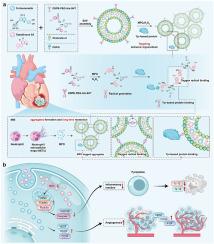Adaptive bioactivable nanosystems for synergistic myocardial infarction therapy using traditional pharmaceutics
IF 18
1区 医学
Q1 ENGINEERING, BIOMEDICAL
引用次数: 0
Abstract
Heart failure resulting from myocardial infarction (MI) is a leading global health concern. Current revascularization therapies cannot fully restore the infarcted myocardium or prevent maladaptive ventricular remodeling. Traditional Chinese medicine with its multitarget regulation and favorable biosafety shows a promising therapeutic potential. Tanshinone IIA (TIIA) and formononetin (FM), two bioactive compounds derived from Salvia miltiorrhiza and Astragalus membranaceus, respectively, exhibit antioxidant, anti-inflammatory, and proangiogenic effects. Herein, a neutrophil-targeted nanomedicine (TF-5NP) was developed to deliver TIIA and FM to the infarcted myocardium for mitigating oxidative damage and promoting angiogenesis. TF-5NP was synthesized by coassembling bis-5-hydroxytryptamine-modified 1,2-distearoyl-sn-glycero-3-phosphoethanolamine–polyethylene glycol–carboxylic acid with cholesterol and lipid 1,2-distearoyl-sn-glycero-3-phosphoglycerol, which binds to troponin in the infarcted myocardium. This nanomedicine reduces inflammation and cardiomyocyte damage and improves cardiac function in porcine MI models, with therapeutic effects lasting for ∼28 d. These findings suggest that TF-5NP use is a promising approach for treating post-MI maladaptive remodeling and heart failure.

应用传统药物协同治疗心肌梗死的适应性生物活性纳米系统
心肌梗死引起的心力衰竭是一个主要的全球健康问题。目前的血运重建治疗不能完全恢复梗死心肌或防止不适应的心室重构。中药以其多靶点调控和良好的生物安全性显示出良好的治疗潜力。丹参酮IIA (TIIA)和刺芒花素(FM)是分别从丹参和黄芪中提取的两种生物活性物质,具有抗氧化、抗炎和促血管生成的作用。本研究开发了一种中性粒细胞靶向纳米药物(TF-5NP),将TIIA和FM输送到梗死心肌,以减轻氧化损伤并促进血管生成。TF-5NP是由双-5-羟色胺修饰的1,2-二硬脂酰-sn-甘油-3-磷酸乙醇胺-聚乙二醇-羧酸与胆固醇和脂质1,2-二硬脂酰-sn-甘油-3-磷酸甘油共组装而成的,其与梗死心肌中的肌钙蛋白结合。在猪心肌梗死模型中,这种纳米药物可以减少炎症和心肌细胞损伤,改善心功能,治疗效果持续~ 28天。这些发现表明,使用TF-5NP是治疗心肌梗死后适应性重构和心力衰竭的一种有希望的方法。
本文章由计算机程序翻译,如有差异,请以英文原文为准。
求助全文
约1分钟内获得全文
求助全文
来源期刊

Bioactive Materials
Biochemistry, Genetics and Molecular Biology-Biotechnology
CiteScore
28.00
自引率
6.30%
发文量
436
审稿时长
20 days
期刊介绍:
Bioactive Materials is a peer-reviewed research publication that focuses on advancements in bioactive materials. The journal accepts research papers, reviews, and rapid communications in the field of next-generation biomaterials that interact with cells, tissues, and organs in various living organisms.
The primary goal of Bioactive Materials is to promote the science and engineering of biomaterials that exhibit adaptiveness to the biological environment. These materials are specifically designed to stimulate or direct appropriate cell and tissue responses or regulate interactions with microorganisms.
The journal covers a wide range of bioactive materials, including those that are engineered or designed in terms of their physical form (e.g. particulate, fiber), topology (e.g. porosity, surface roughness), or dimensions (ranging from macro to nano-scales). Contributions are sought from the following categories of bioactive materials:
Bioactive metals and alloys
Bioactive inorganics: ceramics, glasses, and carbon-based materials
Bioactive polymers and gels
Bioactive materials derived from natural sources
Bioactive composites
These materials find applications in human and veterinary medicine, such as implants, tissue engineering scaffolds, cell/drug/gene carriers, as well as imaging and sensing devices.
 求助内容:
求助内容: 应助结果提醒方式:
应助结果提醒方式:


